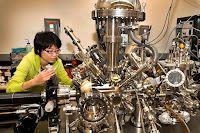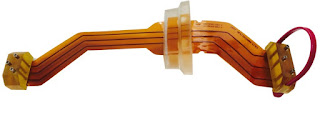 |
| Heat transfer shown by melting ice. |
Heat transfer is the movement of heat from one body or substance to another by radiation, conduction, convection or a combination of these processes. When heating a pan of water over a gas flame for example, all three forms of heat transfer are taking place. Heat from the flame radiates in all directions. Conduction takes place with the transfer of heat from the burner to the metal pan. This heat transfer is also responsible for making the handle hot after a period of time. The water is heated by the process up convection which is a circular movement caused by heated water rising and cold water falling.
The process of heat transfer also occurs when an object cools. If a mug of hot coffee is left standing on a cold kitchen countertop its temperature will gradually decrease as heat is lost. The heat energy dissipates by conduction through the mug to the table top, by convection as the liquid rises cools, and sinks, and by the radiation of heat into the surrounding air.
One way to conserve the heat of a liquid and prevent heat transfer is to place it in a thermos. The use use of a vacuum chamber with silvered surfaces along with low conductive materials can greatly improve the amount of heat or cold that is lost to the surrounding environment.
In between the silver glass walls of a thermos lies a vacuum. In the case of a hot liquid, heat transfer by convection through the vacuum is greatly restricted due to the absence have air molecules necessary to facilitate the transfer of heat. The lack of physical contact between the inside and outside walls of the thermos due to this airless space also greatly inhibits the movement of heat by conduction.
Heat loss by radiation is prevented by the silvered walls reflecting radiant energy back into the thermos. Some conduction of heat through the stopper and glass can be expected, but this too is limited because they are made of materials with very low conductivity. Thus the temperatures of both hot and cold liquids can be maintained by a properly designed thermos that limits the transfer energy through radiation, convection, and conduction.
Heat capacity is the amount of heat required to change the temperature of an object or substance by one degree Celsius. The heat capacity of water varies depending on its phase. As solid ice, the heat capacity of water is .5 calories per gram for every one degree Celsius, which means it takes half a calorie to raise the temperature of one gram of ice one degree Celsius. As a liquid, waters heat capacity is one calorie per gram for every one degree Celsius. So it takes one calorie of heat energy to raise one gram of water one degree Celsius.
The processes a phase change between solid liquid and gas also require a specific amount of heat energy. The amount of energy required to change a liquid into a solid or a solid into a liquid is known as heat of fusion. The amount of heat required to change one gram of ice to water is 80 calories. Similarly, the heat of vaporization is the energy required to transform a liquid into a gas. It requires 540 calories to change one gram of liquid water into a gas. With these values its easy to calculate exactly how many calories of heat energy are required to transform one gram of ice, at absolute zero, to steam.
To warm 1 gram a ice from -273 degrees Celsius, to 0 degrees celsius, would be 273 times .5 gram per calorie, or about 140 calories. The phase change of one gram a ice to liquid water requires 80 calories. Then to heat the water from zero degrees Celsius to 100 degrees Celsius with the heat capacity at one calorie per gram, would require 100 calories. The final phase change of one gram of boiling water to steam would require an additional 540 calories. Adding all of these values together yields 860 calories, the amount of heat energy it takes to transform one gram of ice, at absolute zero, to steam.

